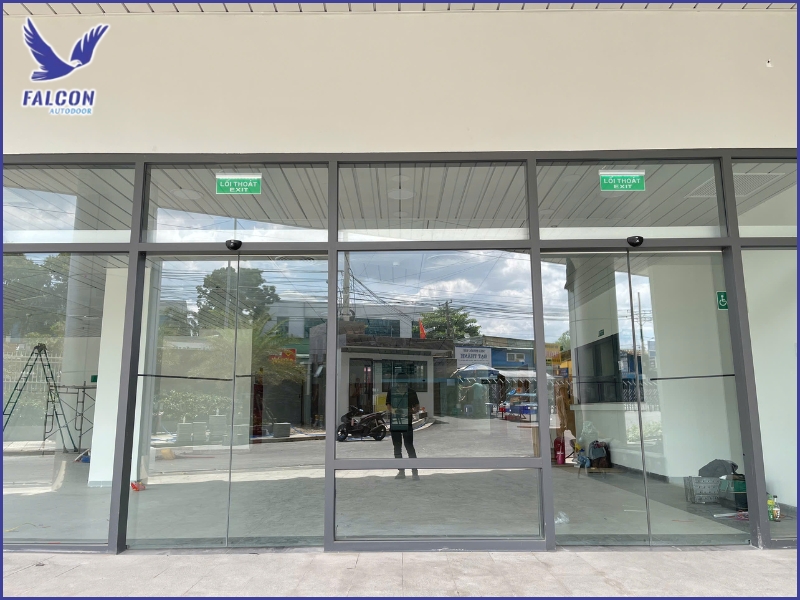The trend of smart automatic doors integrated with IoT
In the era of Industry 4.0, automation is transforming how people interact with living and working spaces. Smart automatic doors integrated with IoT technology are among the most notable advancements, offering enhanced convenience, remote control, and real-time monitoring. In this article, Thuy Linh Long explores how IoT is reshaping the operation and management of automatic door systems in modern buildings.
1. Smart automatic doors - A new step in entrance technology
Smart automatic doors combine traditional motion-based automation with intelligent connectivity and data communication. Instead of merely opening and closing when movement is detected, these systems can now communicate with digital platforms, analyze usage patterns, and adjust operations to improve efficiency and user experience. This marks a significant shift in how access control is implemented in contemporary environments.
1.1 What defines a smart automatic door
A smart automatic door is designed to connect to the Internet and interact with external devices such as smartphones, tablets, or centralized control systems. Beyond basic automated movement, the door can collect operational data, monitor status in real time, and respond to commands remotely. This allows system administrators to manage accessibility dynamically and users to experience seamless entry without physical interaction.
1.2 The role of IoT in smart door systems
IoT (Internet of Things) technology enables sensors, motors, controllers, and security modules to operate as synchronized components. Through cloud connectivity, the system can send notifications, detect anomalies, and receive software updates. Users can view door status, configure settings, or authorize access remotely. This integration significantly enhances reliability, security, and adaptability compared to traditional automatic door systems.

2. Benefits of integrating IoT into automatic doors
The application of IoT expands the functionality of automatic doors beyond convenience. It allows organizations, facility managers, and homeowners to optimize energy use, improve access control, and reduce long-term maintenance costs. These benefits make IoT-enabled doors suitable for both commercial and high-traffic public buildings.
2.1 Flexible remote control and management
Because the system connects to the Internet, users can operate the door at any time from digital devices. Administrators can schedule opening hours, lock or unlock doors from a distance, and manage user permissions. This flexibility is especially valuable in buildings with multiple restricted areas, ensuring that each access point is controlled efficiently without requiring staff to be physically present.
2.2 Enhanced security and safety assurance
Smart automatic doors can integrate advanced authentication systems such as facial recognition, fingerprint scanning, RFID badges, and high-resolution surveillance cameras. Every entry and exit event can be recorded and stored, creating a reliable audit trail. This minimizes unauthorized access and strengthens overall building security. In emergency conditions, the system can also trigger automatic unlock responses to support safe evacuation.
2.3 Energy savings and reduced operational costs
IoT-based sensors ensure that the door only operates when needed and enters standby mode at appropriate times. The system can detect declining performance in motors or sensors, sending early alerts to maintenance teams. This prevents costly breakdowns, extends equipment lifespan, and lowers electricity consumption. As energy efficiency becomes a priority in building management, this is a highly practical advantage.

3. Applications of IoT-enabled automatic doors in modern facilities
The versatility of IoT connectivity allows automatic doors to be adapted to various building types. Intelligent access control improves not only security and movement efficiency but also the overall experience of users in public and private environments.
3.1 Office buildings and commercial centers
In large office buildings, IoT automatic doors can coordinate with facial recognition checkpoints or employee ID systems to streamline monitored entry. Facility managers can track visitor volume during different times of the day and adjust operating patterns accordingly. This helps prevent congestion at entrance points and reduces unnecessary energy use during periods of low activity.
3.2 Hotels, resorts, and luxury hospitality environments
For hospitality facilities, customer experience is a priority. Smart automatic doors can synchronize with room assignment systems, enabling doors to open when registered guests arrive and secure themselves when rooms are vacated. They can also integrate with lighting and HVAC systems to create energy-saving, personalized comfort settings that enhance guest satisfaction.
3.3 Hospitals, airports, and smart industrial facilities
In hospitals, touchless operation helps maintain sterile conditions and limit contamination. At airports or industrial plants, IoT access control improves accuracy in monitoring employee movement, tracking operational flow, and detecting unauthorized access attempts. Data collected from access logs can later be used for audits, safety reviews, or compliance checks.

4. Key technologies used in IoT-enabled automatic doors
Modern automatic doors are evolving from simple mechanical systems into intelligent, learning-based devices. They are now capable of recognizing users, responding to real-time environment changes, and adapting operating behavior to improve performance and safety.
4.1 Multi-zone motion sensors and intelligent recognition
Multi-point sensor arrays detect movement direction, distance, and approach speed with higher precision than basic motion detectors. Some advanced systems also integrate facial recognition or AI-based user identification. This ensures that the door opens only for authorized individuals and prevents unintentional activation in restricted zones.
4.2 Integration with building management systems (BMS)
Smart automatic doors can be fully synchronized with Building Management Systems. All operation logs, usage frequencies, maintenance alerts, and environmental data are accessible on a centralized dashboard. This allows facility managers to efficiently control multiple doors across different floors or zones from a single platform.
4.3 AI and machine learning capabilities
AI enables the door to analyze behavior patterns and adjust response timing, opening duration, or closing speed. Over time, the system can anticipate high traffic periods and optimize performance accordingly. Machine learning also supports predictive maintenance, helping detect early signs of malfunction and reducing repair downtime.

Smart automatic doors integrated with IoT are more than just a trend they represent a forward-thinking approach to efficient, secure, and user-centered building management. If you are planning to upgrade your facility with high-performance automatic door systems, Thuy Linh Long is here to support you. Contact us today for expert consultation and customized installation recommendations for your project.
THUY LINH LONG SERVICES TRADING COMPANY LIMITED
DISTRIBUTOR
Address: 243D Vuon Lai Street, Phu Tho Hoa Ward, Tan Phu District,
Ho Chi Minh City, Vietnam.
Tel: +84 28 22497999
E-mail: cuatudong24h@gmail.com
SUPPLIER
KUM YANG MATERIALS CO.,LTD
Address: 124-60, Myeongdong-ro, Hallim-myeon,
Gimhae-si, Gyeongsangnam-do, 50851, Korea.
Tel: 82-55-345-8380










